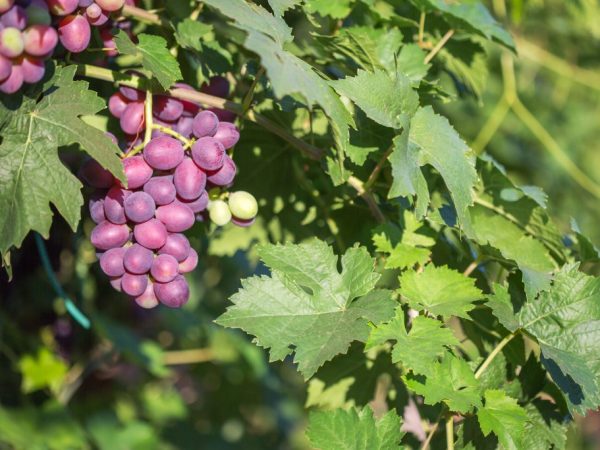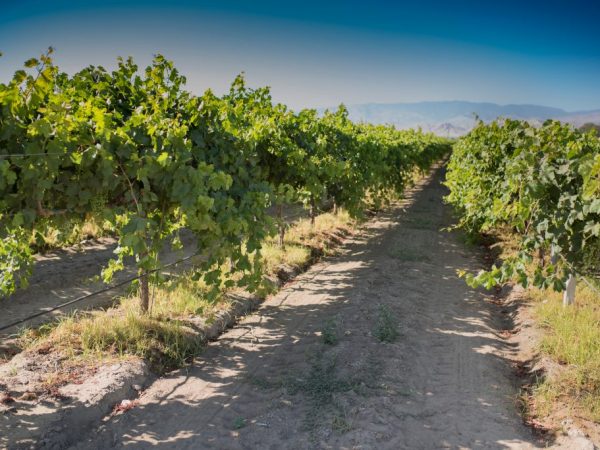Growing Amirkhan grapes
When growing on a plot of vines, it is important to select a Varietal variety that can bring a consistently high yield in all conditions. One of these is the Amirkhan grape.

Growing Amirkhan grapes
Characteristics of the variety
The Amirkhan table grape variety is a representative of the early ripening group. The duration of the growing season (the time from budding to full ripeness of the berries) is 110-120 days.
Bush characteristic
The Amirkhan vine differs from the rest in its large size. The shrub reaches a medium to high height. Shoots are distinguished by a high growth rate. Flowers are bisexual.
Leaves are ovoid with weak dissection. Amirkhan grape foliage color is light green.
Characteristics of the fetus
According to the description, clusters with large berries. The shape of the bunch is cylindrical-conical. The average weight ranges from 400-800 g. The density of the bunch is high. This is the reason why the fruit in the middle of the cluster is irregular.
The mass of one berry is 4-6 g. The shape of the fruit is neat oval. The berries are pink. The presence of a yellow tint is possible. The seeds in the fruits are small, practically not felt when consuming grapes. The pulp is juicy. The taste is simple, with light notes of nutmeg. The skin of the fruit is thin and tender.
Overloading the bush with fruiting bunches has a negative effect on the quality of the crop. The ripening period of the fruits increases, the size of the berries decreases.
Growing features
When growing on a plot of grape culture, everything is important, from the choice of a place for planting the cuttings to the slightest subtleties of caring for the vine. Only complete observance of agricultural technology makes it possible to obtain abundant and high-quality harvests from year to year.
Planting in soil
The variety, known as Amirkhan, is picky about the soil, its composition and the place of planting. Culture requires a lot of light and warmth. Preference is given to the southwestern or southern sides of the site. They also take care of good protection from strong winds.
Grapes of this variety grow well on fertile soils. The best options are black soil or loamy soil. In the case of low fertility of the land on the site, it is more acceptable to grow a crop by means of grafting.
Planting the cuttings in the soil is carried out in the spring, after a stable warm temperature has been established. It is most appropriate to prepare the landing pits in the fall.
Description of the preparation process for the landing hole:
- At a distance of 2.5 m from each other, pits are dug with a depth of no more than 0.8 m.
- A drainage layer of crushed stone is laid at the bottom of the hole.
- A layer of soil mixture of chernozem, humus, sand and mineral fertilizers is laid on top.
- A stake is placed in the center, which will support the vine.
Before planting, the roots of a young seedling are kept for 48 hours in a special solution to accelerate root growth. After that, the seedlings are placed in the holes, gently straightening the root system.The shank is immersed to the level of the neck. After that everything is sprinkled with soil and watered abundantly.
Care features

Extra foliage needs to be removed from plants
To avoid overloading the bush, spring pruning is carried out. As a result, no more than 40 fertile buds remain in the vineyard.
Weakened or superfluous stepchildren are also subject to removal. For better protection against infections and good ventilation, thinning of the vineyard foliage is carried out.
The crop is sprayed with fungicides several times during the season. The last use of drugs is carried out before the berries ripen.
Small portions of nitrogen, potash and phosphorus fertilizers are applied throughout the season. Organic feeding is carried out every 2-3 years. The main indicator for feeding is the condition of the soil.
Watering the vineyard is carried out as needed. Avoid oversaturation of the soil with moisture. More frequent watering is carried out during dry periods.
Diseases and pests
The variety receives the most significant damage from wasps, which devour a bush with fruit bunches. For this reason, the berries do not lose their attractive appearance, but also their commercial and taste characteristics.
The description of the control of these pests includes the following methods:
- elimination of nests on the site;
- placing traps;
- using poisoned baits;
- spraying brushes with saline;
- protection of bunches by means of special nets or bags.
With heavy rainfall, the likelihood of developing such a fungal disease as gray rot increases. It leads to the death of young shoots and rotting of ripe fruits.
The main method of control is treatment using fungicides. In practice, Ronilan 0.1% and Rovral 0.075% performed well.
Conclusion
Varietal variety Amirkhan is a table variety of pink grapes with good taste and commercial characteristics.


